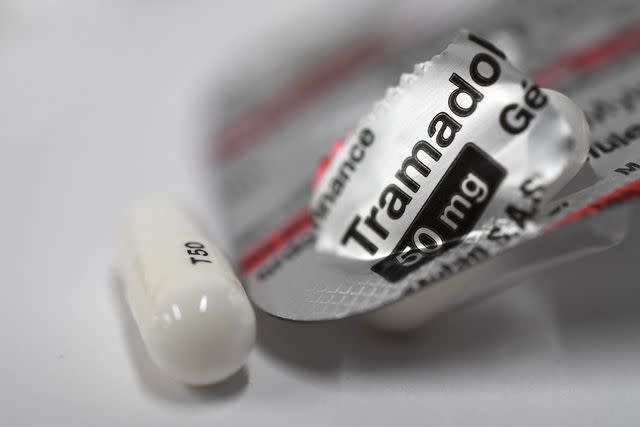Is Tramadol a Controlled Substance?
Medically reviewed by Erika Prouty, PharmD
In 2014, tramadol was classified as a Schedule IV (or Schedule 4) controlled substance. Tramadol is an opioid medication with a potential for abuse, misuse, and harm. As a controlled substance, tramadol is subject to more restrictive regulations when prescribed and used.
This article will discuss tramadol's classification as a controlled substance, what it means for a drug to be classified as one, and its regulation across different states.

Getty Images / FRED TANNEAU / Contributor
Tramadol as a Controlled Substance
Tramadol is an opioid medication used to help manage moderate to severe pain in adults.
The Food and Drug Administration (FDA) initially approved the medication as a noncontrolled substance in 1995. However, medical professionals were concerned about tramadol's potential for abuse and addiction. Therefore, in 2014, the Drug Enforcement Administration (DEA) made tramadol a Schedule IV controlled substance.
A Schedule IV medication is defined as a drug that has a low risk of dependence and addiction. In comparison to other opioids such as oxycodone or codeine, tramadol does not have a high abuse risk, but there is a potential for harm if not taken as instructed by your healthcare provider.
Schedule IV prescriptions can be refilled a maximum of five times within six months. After five refills within six months, you need to get a new prescription from your healthcare provider.
Is Tramadol a Controlled Substance in All States?
The DEA categorizes medications based on a federal controlled substance schedule. However, individual states can change the schedule of the medication to be more restrictive if they feel there is an increased risk of abuse within that state. Despite this rule, tramadol is a Schedule IV controlled substance in all 50 states.
Understanding Scheduling for Controlled Substances
Controlled medications are placed into a scheduled class based on their risk of abuse or dependence. The class of drug schedules ranges from Schedule I (or Schedule 1) to Schedule V (or Schedule 5). Schedule I has the highest risk of abuse, while Schedule V has the lowest risk of abuse.
Schedule I Drugs
Schedule I substances are drugs that have no currently accepted medical use and a high risk of abuse and addiction, as defined by the FDA. Common Schedule I drugs are:
Heroin
LSD (lysergic acid diethylamide)
Cannabis
Ecstasy. (MDMA)
Synthetic cathinones (bath salts)
Takeaway
Despite being classified as Schedule I, cannabis is allowed for medical use in some states. The Department of Health and Human Services has recommended that cannabis be rescheduled from a Schedule I substance to Schedule III. However, it is still currently categorized as a Schedule I substance.
Schedule II Drugs
Schedule II (or Schedule 2) substances are drugs that have medical benefits but have a high abuse risk with severe physical and mental dependence. Common Schedule II medications are:
Methadose (methadone)
OxyContin (oxycodone)
Fentanyl
Dilaudid (hydromorphone)
Schedule III Drugs
Schedule III substances are drugs with a moderate risk of abuse and dependence and are less dangerous than Schedules I and II drugs. Common Schedule III medications are:
Products with less than 90 milligrams (mg) of codeine
Testosterone
Suboxone (naloxone and buprenorphine)
Schedule IV Drugs
Schedule IV substances are drugs with a low risk of abuse and dependence. While these drugs have a low risk of misuse, there is still a probability that these drugs can be dangerous when not used as intended. Common Schedule IV medications are:
Xanax (alprazolam)
Soma (carisoprodol)
Valium (diazepam)
Ambien (zolpidem)
Tramadol
Schedule V Drugs
Schedule V substances have the lowest risk of abuse compared to the other schedules. Common Schedule V medications are:
Robitussin AC (guaifenesin and codeine)
Lyrica (pregabalin)
What Do I Need to Know About Taking Tramadol?
While there is a potential for abuse, you should not be afraid of taking tramadol, as it is clinically approved to be safe and effective in helping manage your pain.
You should be aware that your prescription is only valid for six months with a maximum of up to five refills, depending on how your healthcare provider prescribed the medication. If you need more than five refills within six months, you must visit your healthcare provider for a new prescription.
As long as you take tramadol exactly as prescribed, there is a low risk of becoming dependent on the medication.
Summary
In 2014, Tramadol was classified as a Schedule IV controlled substance in all 50 states of the United States.
Schedule IV medications have a low risk of abuse and dependence when used as instructed by your healthcare provider. All Schedule IV prescriptions are valid for six months, with a maximum of five refills. In addition, Schedule IV medications can be transferred only once between pharmacies. Despite the regulations and restrictions, tramadol is a safe and effective medication to help relieve your pain.
The author of this article would like to thank and acknowledge Alexya Rosas for contributing to this article.
Read the original article on Verywell Health.

